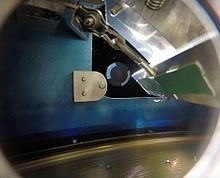Mirka2-rx
MIRKA2-RX is a project of the student satellite group of the University of Stuttgart . The project is a preparatory study for the ongoing CAPE project . Both projects are supervised by the KSat eV association and the Institute for Space Systems at the University of Stuttgart.
description
During the MIRKA2-RX mission, the MIRKA2 re- entry capsule was ejected by the REXUS19 rocket in apogee . The capsule should collect data on its flight behavior, its position and pressure data of the atmosphere in the event . The data should be sent to the ground station via a satellite link.
The REXUS / BEXUS program is offered by the German Aerospace Center , the Center for Applied Space Technology and Microgravity, and the European Space Agency. Student groups have the opportunity to test their experiments in weightlessness. Each team receives a part of the rocket for their experiment, the rocket module. In the module, the experiment is set up, tested and later flown in the REXUS rocket.
Mission goal
The aim of the mission is to qualify the capsule shape, the capsule electronics in weightlessness and the separation mechanism for the subsequent Cubesat mission CAPE. This mission is intended to create a platform with which heat shields can be tested cheaply and comparatively easily.
Preparatory work
In preparation for the REXUS experiment, two larger preliminary experiments were carried out. The first was a drop test with a test capsule that was equipped with an IMU ( Inertial Measurement Unit ) and dropped from a construction crane from a height of around 27 meters in order to test the aerodynamics. During the fall, the capsule always turned back into the desired position with the underside of the capsule facing the oncoming wind. Preliminary tests were carried out with the sensors of the capsule electronics, which documented the fall or the movement of the capsule.
In order to repeat the experiment without disturbing cross winds, the capsule was also tested in a horizontal wind tunnel. The wind tunnel was built together with the Institute for Fluid Mechanics and Hydraulic Fluid Machines (IHS) at the University of Stuttgart . In this experiment, the aerodynamic stability of the capsule from the drop experiment was reproduced and confirmed.
Takeoff and flight
The experiment started on March 18, 2016 at the Esrange Space Center . The capsule was ejected after 126 seconds at an altitude of 77.744 km and when it fell it reached about Mach 4.
With the help of the on-board electronics, GPS coordinates, position, pressure and temperature measurement data were transmitted to the ground station via iridium . The activation mechanism failed, however, so that the electronics in the capsule were only activated when it hit the ground. The capsule was nevertheless found at the transmitted position.
The evaluation of the data showed a 15% longer operating time than expected. Despite strong voltage fluctuations at times, 21 kB were sent at an average of 12.1 bytes / s for 29 minutes and 53 seconds. The evaluation of the landing crater indicated a stable flight. Both the redundant electronics system remaining in REXUS19 and the ejection mechanism worked properly.
The capsule is thus rated as essentially suitable for CAPE. On the basis of the collected data, a thermodynamic analysis and a revision of the electronic subsystems are to be carried out.
Mission dates
Weight (total): approx. 5 kg Weight (capsule): 528 g Dimensions of the module: Radius 150 mm, height 220 mm Dimensions of the capsule: Radius (shoulder): 100 mm, height 79 mm Separation height: 77.744 km Rocket flight time (to ejection): 126 seconds Fall time of the capsule: about 8 minutes Operating time:: 29 minutes 53 seconds
See also
Web links
Individual evidence
- ↑ a b Rexus Bexus . Retrieved April 1, 2016.
- ↑ Birgit Vennemann: Experiment to research heat shields . University communication University of Stuttgart. Retrieved April 1, 2016.
- ↑ Paper: E248 Micro Reentry Capsule 2 REXUS . Archived from the original on April 7, 2016. Retrieved April 1, 2016.
- ↑ Newspaper article: A construction crane from Esslingen is put into the service of science . Retrieved April 1, 2016.
- ↑ Elisa Werler: The REXUS experiment MIRKA2-RX is about to start . IRS Uni Stuttgart. Retrieved April 1, 2016.
- ↑ REXUS 19/20. (No longer available online.) Archived from the original on June 14, 2016 ; accessed on June 12, 2016 . Info: The archive link was inserted automatically and has not yet been checked. Please check the original and archive link according to the instructions and then remove this notice.
- ↑ Manfred Ehresmann, Jean-Pierre Baumann, Daniel Galla et al .: Micro Return Capsule 2 - REXUS Experiment Results. (No longer available online.) Archived from the original on June 14, 2016 ; accessed on June 12, 2016 .


